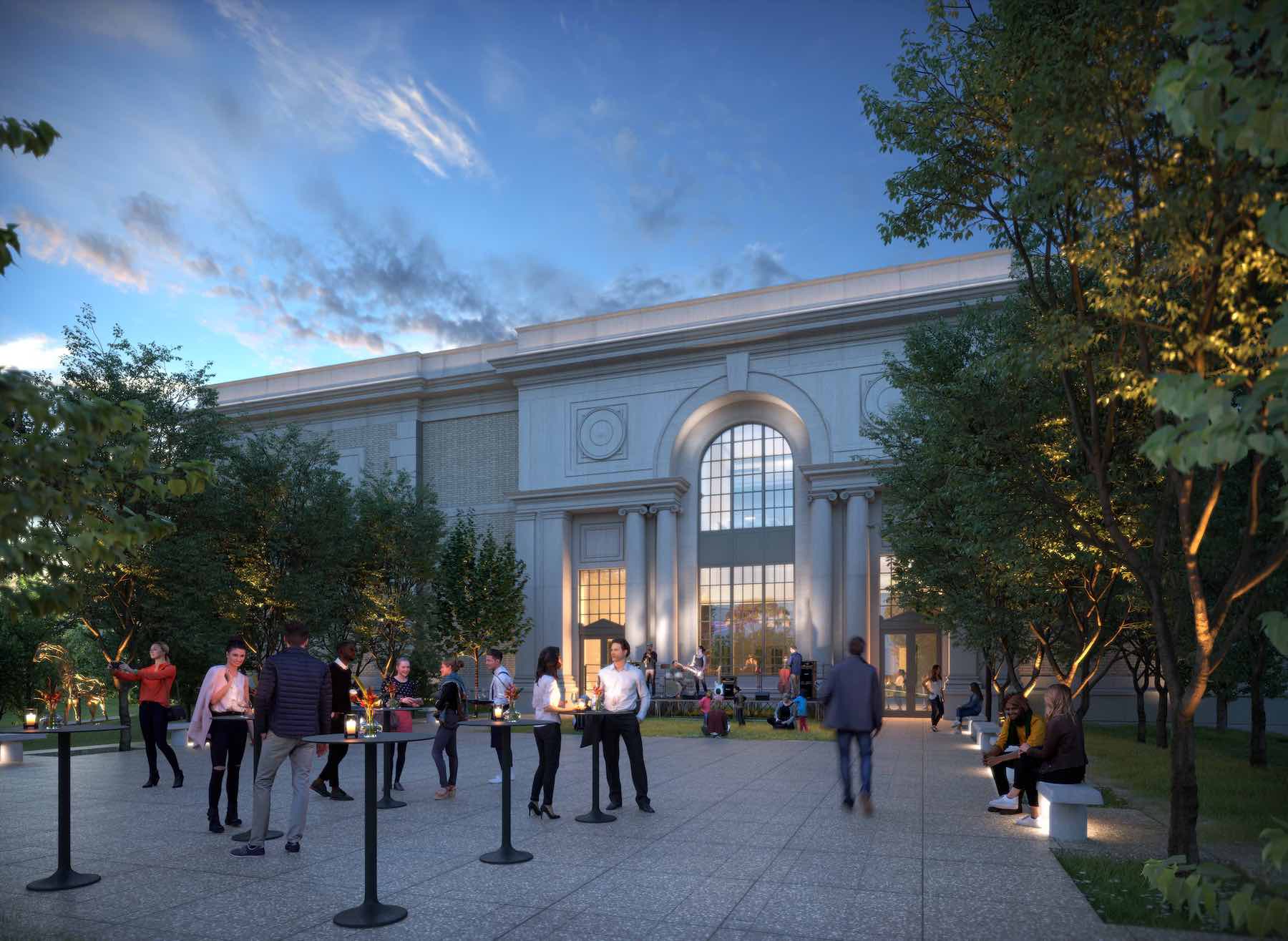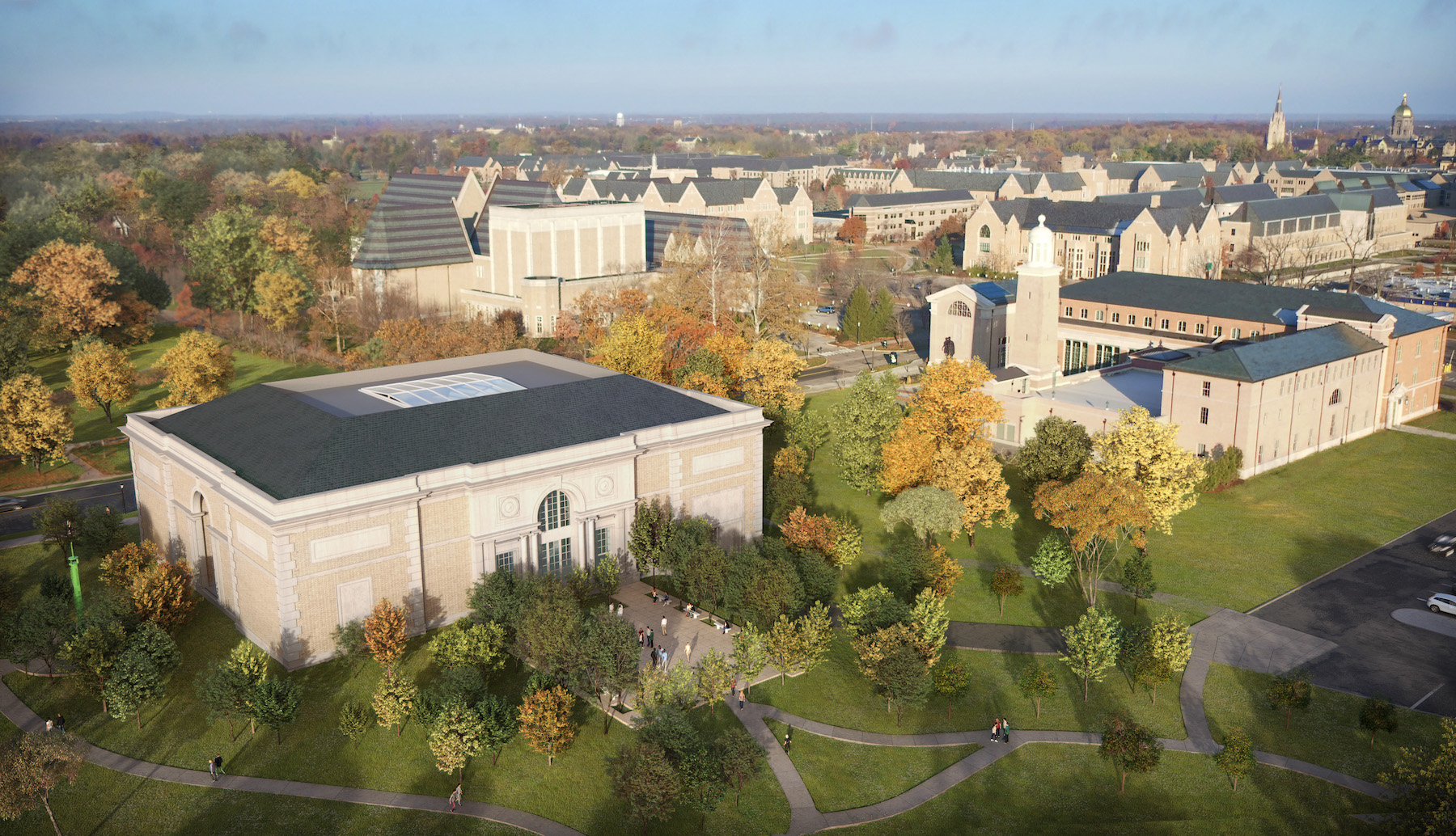Next November, the University of Notre Dame in Indiana is scheduled to open the first phase of Raclin Murphy Museum of Art, a 70,000-sf cultural facility that will eventually replace the campus’ venerable Snite Museum of Art and double the exhibit space available for Notre Dame’s 31,000-item art collection.
The building under construction establishes a new location for the museum, and is considered to be a “front door” to an arts district on the campus’ south side that already includes the DeBartolo Performing Arts Center, the nine-acre Charles B. Hayes Family Sculpture Park, and the Matthew and Joyce Walsh Family Hall of Architecture.
Long-term storage of Notre Dame’s vaunted collection of prints, drawings, and photography, along with most of the museum’s personnel, will remain at Snite until Phase 2 of this complex is realized. Phase 2’s start date and timeline have yet to be disclosed, but what’s known is that it will increase the size of the new museum complex to 132,000 sf, and provide more gallery space, offices, an auditorium, and a works-on-paper study center.
Robert A.M. Stern Architects (RAMSA) is the design architect on this project. The rest of the Building Team includes Bulley & Andrews (GC), the engineering firms Kohler Ronan (MEP), Thornton Tomasetti (SE) and TfL (CE); and Gallagher & Associates (exhibit design). The construction cost has not been disclosed.
Giving exhibits equal weight in the museum
Last week, BD+C interviewed RAMSA’s Melissa DelVecchio, FAIA, Partner; and Anthony McConnell, Senior Associate, about the Raclin museum’s design features within its three floors and a lower level.
DelVecchio noted that new construction was necessitated by the lack of available space near the Snite Museum for expansion. When Snite opened a generation ago, it was on the outer edge of what was then Notre Dame’s campus; now, it’s roughly in the middle of a significantly bigger campus. “It’s hard to find, and there’s no nearby parking,” she said.
Snite only has enough space to exhibit 2-3 percent of the museum’s collection, whereas Raclin will be able to show around 5%. DelVecchio pointed out, as well, that the new building will house a large temporary gallery and loading dock to better attract and handle traveling exhibits, something that Snite was not able to accommodate. The new building also will have more storage space that’s accessible to students for study purposes.

The galleries within Raclin revolve around a central, multi-height atrium that rises to a skylight, and the galleries themselves will have “equal prominence,” said McConnell, compared to some spaces in Snite that relegated the art to “second class” exhibition.
The lower level of Raclin “has no back,” he explained, in that its gallery for International Modern and Contemporary Art blends into the museum’s sculpture court. Raclin is also distinguished on its west side by an oval-shaped working chapel, Our Lady, Queen of Families, that will display some art and be near galleries with ecclesiastic art on display.

From an operational standpoint, the museum is designed to present zero thresholds for patrons with disabilities. That includes the installation of automated door openers for the facility’s restrooms.
The exterior design of this rectangular building is classical, and its materials will match the rest of the arts district and streetscape, said DelVelcchio.
Related Stories
| Aug 11, 2010
Museum celebrates African-American heritage
The Harvey B. Gantt Center for African-American Arts + Culture recently completed construction on the Wells Fargo Cultural Campus in Charlotte, N.C. Designed by the Freelon Group, Durham, N.C., with Batson-Cook's Atlanta office as project manager, the $18.8 million project achieved nearly 100% minority participation.
| Aug 11, 2010
Design for Miami Art Museum triples gallery space
Herzog & de Meuron has completed design development for the Miami Art Museum’s new complex, which will anchor the city’s 29-acre Museum Park, overlooking Biscayne Bay. At 120,000 sf with 32,000 sf of gallery space, the three-story museum will be three times larger than the current facility.
| Aug 11, 2010
Thom Mayne unveils ‘floating cube’ design for the Perot Museum of Nature and Science
Calling it a “living educational tool featuring architecture inspired by nature and science,” Pritzker Prize Laureate Thom Mayne unveiled the schematic designs and building model for the Perot Museum of Nature & Science at Victory Park in Dallas. The $185 million, 180,000-sf structure is 170 feet tall—equivalent to approximately 14 stories—and is conceived as a large...
| Aug 11, 2010
Piano's 'Flying Carpet'
Italian architect Renzo Piano refers to his $294 million, 264,000-sf Modern Wing of the Art Institute of Chicago as a “temple of light.” That's all well and good, but how did Piano and the engineers from London-based Arup create an almost entirely naturally lit interior while still protecting the priceless works of art in the Institute's third-floor galleries from dangerous ultravio...
| Aug 11, 2010
The Art of Reconstruction
The Old Patent Office Building in Washington, D.C., completed in 1867, houses two Smithsonian Institution museums—the National Portrait Gallery and the American Art Museum. Collections include portraits of all U.S. presidents, along with paintings, sculptures, prints, and drawings of numerous historic figures from American history, and the works of more than 7,000 American artists.
| Aug 11, 2010
Silver Award: Please Touch Museum at Memorial Hall Philadelphia, Pa.
Built in 1875 to serve as the art gallery for the Centennial International Exhibition in Fairmount Park, Memorial Hall stands as one of the great civic structures in Philadelphia. The neoclassical building, designed by Fairmount Park Commission engineer Hermann J. Schwarzmann, was one of the first buildings in America to be designed according to the principles of the Beaux Arts movement.







